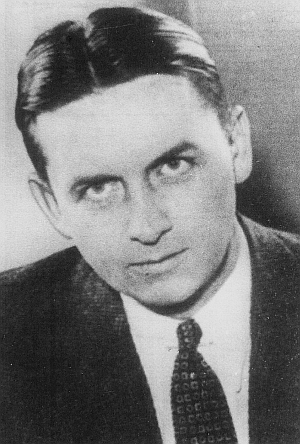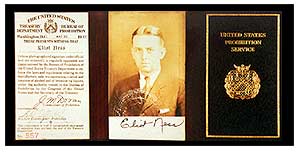Eliot Ness facts for kids
Eliot Ness (April 19, 1903 – May 16, 1957) was an American Prohibition agent. He became famous for his efforts to stop the illegal alcohol trade in Chicago. Ness led a special team of law enforcement agents. They were known as "The Untouchables" because they could not be bribed. After his death, a book about his life, The Untouchables, made him famous. He is remembered as a brave crime fighter.
Contents
Early Life and Education
Eliot Ness was born in Chicago, Illinois, on April 19, 1903. He was the youngest of five children. His parents were immigrants from Norway who owned a bakery.
Ness went to Christian Fenger High School in Chicago. He later studied at the University of Chicago. In 1925, he earned a degree in political science and business administration. He also took a class in criminology from August Vollmer. Vollmer was a famous police reformer. His ideas helped shape Ness's career in law enforcement.
Career as a Law Enforcement Officer
Joining the Prohibition Bureau
Eliot Ness started his career in law enforcement in 1926. His brother-in-law, who worked for the Bureau of Investigation, helped him. Ness joined the U.S. Treasury Department and worked for the Bureau of Prohibition in Chicago.
Fighting Al Capone and the Untouchables
In 1930, President Herbert Hoover wanted to stop the famous gangster Al Capone. Capone was making a lot of money from illegal alcohol sales. A special team of agents was put together to target Capone's illegal businesses. Eliot Ness, who was 27 years old, was chosen to lead this team.
Chicago's police force was known for being corrupt. Ness carefully chose his team members. He picked agents who could not be bribed. This small group of about ten agents became known as "The Untouchables."
Raids and Financial Damage
Starting in March 1931, Ness and his team began raiding Capone's illegal alcohol factories. They destroyed many breweries and distilleries. These raids cost Capone millions of dollars in lost income. The team used wiretapping to find out where the illegal operations were.
Capone's gang tried to bribe Ness. They offered him $2,000 every week. Ness refused the money. This refusal, and the fact that his team could not be intimidated, led a newspaper reporter to call them "untouchables." This nickname quickly became famous.
Capone's Conviction
Ness's efforts hurt Capone's business a lot. In June 1931, Capone was charged with many violations of the law against alcohol. However, he was eventually sent to prison for not paying his taxes. On October 17, 1931, Capone was found guilty. He was sentenced to eleven years in prison. Ness was one of the agents who took Capone to prison in 1932. This was the only time they are known to have met in person.
Career After Prohibition
In 1932, Ness was promoted to Chief Investigator of the Prohibition Bureau for Chicago. When the law against alcohol ended in 1933, he continued working as an alcohol tax agent. In 1934, he moved to Cleveland, Ohio.
In 1935, the Mayor of Cleveland hired Ness as the city's Safety Director. This job put him in charge of both the police and fire departments. Ness started a program to make the police force better and more modern. He also worked to improve traffic safety. He tried to stop organized crime in Cleveland.
Ness's career in Cleveland faced challenges over time. In 1942, he moved to Washington, D.C., to work for the government. Later, he became the chairman of the Diebold Corporation, a security company.
In 1947, Ness ran for Mayor of Cleveland but did not win. After this, he left Diebold in 1951. He took on various jobs, like working in a bookstore. In his later years, Ness faced financial difficulties. He was not wealthy when he died, and his role in stopping Al Capone was largely forgotten for a while.
Personal Life
Eliot Ness was married three times. He was married to Edna Stahle from 1929 to 1938. His second wife was Evaline Michelow, from 1939 to 1945. His third wife was Elisabeth Andersen Seaver, whom he married in 1946. They were married until his death. Ness also had an adopted son named Robert.
Death
Eliot Ness died on May 16, 1957, at his home in Coudersport, Pennsylvania. He was 54 years old and died from a heart attack. His body was cremated. His ashes were scattered in a pond at Lake View Cemetery in Cleveland. Later, a memorial was placed there in his honor.
Legacy and Pop Culture
Books, TV, and Movies
Eliot Ness's life has inspired many books, TV shows, and movies. He worked with Oscar Fraley on a book called The Untouchables. This book was published shortly after Ness died and sold many copies. While some parts might be fictionalized, it is mostly based on real events.

The book led to a popular 1959 TV series also called The Untouchables. Actor Robert Stack played Eliot Ness in this show. A famous 1987 movie, also called The Untouchables, starred Kevin Costner as Ness. These shows and movies helped make Ness famous as a crime fighter.
Many other stories, plays, and comic books have been made about Eliot Ness. He has been shown in TV shows like Boardwalk Empire. Writer Max Allan Collins has used Ness as a character in his detective novels and graphic novels.
Honoring Eliot Ness
In 2014, some U.S. Senators suggested naming the headquarters of the Bureau of Alcohol, Tobacco, Firearms and Explosives after Ness. They wanted to honor him as a public servant and American hero. However, some people in Chicago disagreed. They felt his later career was not as successful.
Despite the debate, the main hall in the ATF headquarters building was later named for Eliot Ness. It now has an exhibit about him and the Untouchables.
Festival and Museum
Coudersport, Pennsylvania, the town where Ness died, holds an annual "Eliot Ness Festival." This festival celebrates his life and work. It includes events like talks by authors and antique car shows.
In 2019, an "Eliot Ness Museum" opened in Coudersport. It has old cars and exhibits that tell the story of Ness's life and career.
See also
 In Spanish: Eliot Ness para niños
In Spanish: Eliot Ness para niños




